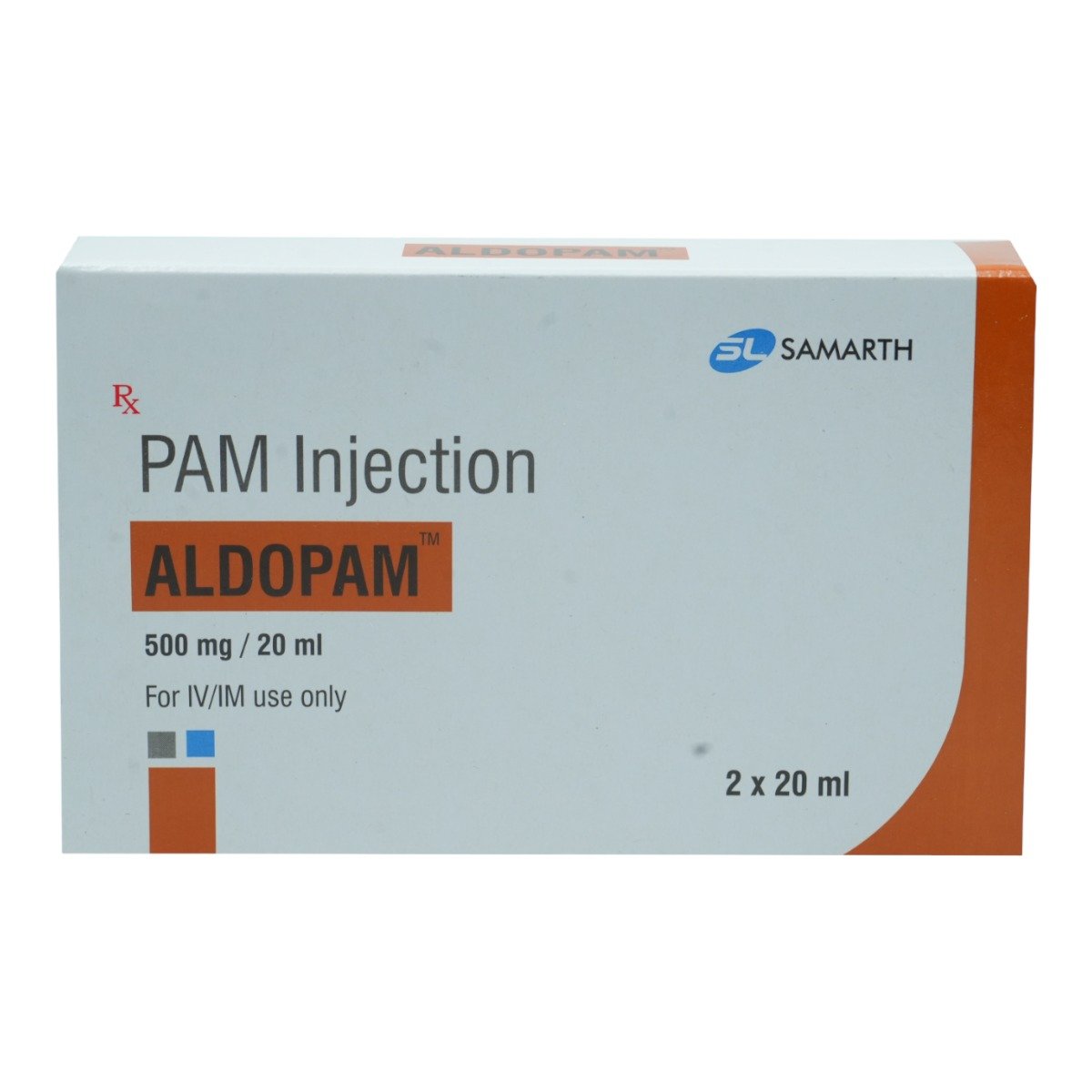Pam Injection 20 ml


MRP ₹220
(Inclusive of all Taxes)
₹33.0 Cashback (15%)
Provide Delivery Location
Online payment accepted
 Prescription drug
Prescription drugWhats That
Composition :
Manufacturer/Marketer :
Consume Type :
Expires on or after :
Return Policy :
About Pam Injection
Pam Injection belongs to the oxime class of drugs. Pralidoxime is used alone or together with atropine to treat poisoning caused by organic phosphorus pesticides or chemicals. It is also used to treat an overdose of drugs that treat myasthenia gravis.
Pam Injection contains Pralidoxime, a cholinesterase reactivator. It works by reactivating the enzyme cholinesterase (mainly outside the central nervous system), which has been inactivated by phosphorylation due to an organophosphate pesticide or related compound.
A qualified healthcare professional will administer Pam Injection. You may experience mild to moderate pain at the site of injection, blurred vision, diplopia (double vision), impaired accommodation, dizziness, headache, drowsiness, nausea, tachycardia (fast heartbeat), increased systolic and diastolic blood pressure, hyperventilation (rapid or deep breathing), and muscular weakness. Most of these side effects do not require medical attention and gradually resolve over time. However, if the side effects persist, inform your doctor.
Before taking Pam Injection, let your doctor know about all your medical conditions, sensitivities, and ongoing medications. Also, inform your doctor if you are pregnant, planning pregnancy, or breastfeeding. Pam Injection may cause blurred vision and diplopia (double vision); it impacts your ability to drive or operate machinery.
Uses of Pam Injection
Directions for Use
Key Benefits
Pam Injection contains Pralidoxime, a cholinesterase reactivator that belongs to the oxime class of drugs. Pralidoxime is together with another medicine called atropine to treat poisoning caused by organic phosphorus pesticides (such as diazinon, malathion, sarin and parathion). Pralidoxime injection is also used to treat an overdose of medicines (such as neostigmine, ambenonium, and pyridostigmine) that treat myasthenia gravis. It works by reactivating the enzymes (cholinesterase) blocked by many pesticides or medicines. Poisoning with these substances or drugs weakens your muscles, including those that let you breathe. Pralidoxime is used to help you regain muscle strength.
Storage
- Inform your doctor about dizziness symptoms. They may adjust your medication regimen or prescribe additional medications to manage symptoms.
- Follow your doctor's instructions for taking medication, and take it at the same time every day to minimize dizziness.
- When standing up, do so slowly and carefully to avoid sudden dizziness.
- Avoid making sudden movements, such as turning or bending quickly, which can exacerbate dizziness.
- Drink plenty of water throughout the day to stay hydrated and help alleviate dizziness symptoms.
- If you're feeling dizzy, sit or lie down and rest until the dizziness passes.
- Track when dizziness occurs and any factors that may trigger it, and share this information with your doctor to help manage symptoms.
Drug Warnings
Pam Injection is not recommended as an antidote for carbamate pesticide overdose since it may enhance carbaryl toxicity or known hypersensitivity to the drug. Before taking Pam Injection, inform your doctor of all your medical problems, sensitivities, and medicines. Also, let your doctor know if you are pregnant, want to become pregnant, or are breastfeeding. Do not drive or operate machinery because Pam Injection may cause diplopia (double vision), decreased accommodation, and dizziness.
Drug-Drug Interactions
Drug-Drug Interactions
Login/Sign Up
Pam Injection 20 ml and Pramlintide when used together may enhance the effects of the other, which may increase the risk of side effects. .
How to manage the interaction:
Co-administration of Pam Injection 20 ml with Pramlintide is not recommended as it can possibly result in an interaction, it can be taken if a doctor has advised it. Do not discontinue any medications without a doctor's advice.
Drug-Food Interactions
Drug-Food Interactions
Login/Sign Up
Side Effects of Pam Injection
- Mild to moderate pain at the site of injection
- Blurred vision
- Diplopia (double vision)
- Impaired accommodation
- Dizziness
- Headache
- Drowsiness
- Nausea
- Tachycardia
- Increased systolic and diastolic blood pressure
- Rapid or deep breathing
- Muscular weakness
Habit Forming
Therapeutic Class
All Substitutes & Brand Comparisons
RX
Out of StockNeopam 500mg Injection
Troikaa Pharmaceuticals Ltd
₹65.25
(₹2.94/ 1ml)
70% CHEAPERRX
Aldopam Injection 20 ml
Samarth Life Sciences Pvt Ltd
₹97
(₹4.27/ 1ml)
56% CHEAPERRX
Out of StockCBCPAM INJECTION 20ML
Chandra Bhagat Pharma Ltd
₹195
(₹8.78/ 1ml)
11% CHEAPER
Product Substitutes
Author Details
We provide you with authentic, trustworthy and relevant information
Drug-Diseases Interactions
Drug-Diseases Interactions
Login/Sign Up
FAQs
Pam Injection contains Pralidoxime, a cholinesterase reactivator. It works by reactivating the enzyme cholinesterase (mainly outside the central nervous system), which has been inactivated by phosphorylation due to an organophosphate pesticide or related compounds and medicines.
Pam Injection is an antidote Antidote for organophosphorus nerve agent poisoning, including chlorosarin, cyclosarin (GF), R-VX, tabun (GA), sarin (GB), VX, soman (GD), chlorosoman and organophosphorus pesticides.
Pralidoxime injection is also used to treat an overdose of medicines (such as neostigmine, ambenonium, and pyridostigmine) that treat myasthenia gravis.
Drug-Drug Interactions Checker List
- MIVACURIUM
- SUCCINYLCHOLINE
Disease/Condition Glossary
Organophosphorus poisoning occurs after dermal, respiratory, or oral exposure to pesticides or nerve agents. Poisoning can occur after short or long-term exposure. It can cause nerve damage and disrupt hormone production in humans and animals. Organophosphates are also toxic to plants and insects. Agricultural workers and others who handle agricultural chemicals may be at risk, with most exposure occurring in rural areas.

Have a query?
Buy best Poisoning & Drug Dependence products by
Cipla Ltd
Sun Pharmaceutical Industries Ltd
Troikaa Pharmaceuticals Ltd
Intas Pharmaceuticals Ltd
Samarth Life Sciences Pvt Ltd
Tripada Healthcare Pvt Ltd
Glenmark Pharmaceuticals Ltd
Itc Ltd
Lupin Ltd
Sparsha Pharma International Pvt Ltd
Celon Laboratories Pvt Ltd
Consern Pharma Ltd
D D Pharmaceuticals Pvt Ltd
Fusion Health Care Pvt Ltd
Harson Laboratories
Msn Laboratories Pvt Ltd
Neon Laboratories Ltd
Novartis India Ltd
Pfizer Ltd
Psyco Remedies Ltd
Wockhardt Ltd
Abeena Pharma
Aimcad Biotech Pvt Ltd
Arco Lifesciences (I) Pvt Ltd
Bharat Biotech
Brainwave Healthcare Pvt Ltd
Chandra Bhagat Pharma Ltd
Cipla Health Ltd
Cnx Health Care Pvt Ltd
Crescent Formulations Pvt Ltd
East India Pharmaceutical Works Ltd
Healers Pharmaceuticals Pvt Ltd
Icon Life Sciences
K C Laboratories
Koye Pharmaceuticals Pvt Ltd
Leeford Healthcare Ltd
Lyf Healthcare
Micro Labs Ltd
Natco Pharma Ltd
Ns Pharma
Ozone Pharmaceuticals Ltd
Steris Healthcare
TTK Healthcare Ltd
Theo Pharma Pvt Ltd
Treatsure Pharma
West Coast Pharmaceuticals Pvt Ltd
Alcohol
Safe if prescribed
Avoid consuming alcohol. Consult your doctor for more information.
Pregnancy
Consult your doctor
Inform your doctor if you are pregnant or suspect pregnancy. Your doctor will weigh the benefits and potential risks before prescribing Pam Injection.
Breast Feeding
Consult your doctor
Caution is advised. Let your doctor know if you are a nursing mother before taking Pam Injection; your doctor may suggest stopping breastfeeding for a certain period.
Driving
Safe if prescribed
Pam Injection may cause blurred vision and diplopia (double vision). It impacts your ability to drive or operate machinery.
Liver
Consult your doctor
Inform your doctor before receiving Pam Injection if you have had a liver impairment/disorder history. Your doctor will weigh the benefits and potential risks before prescribing Pam Injection.
Kidney
Consult your doctor
Caution should be exercised. Inform your doctor before receiving Pam Injection if you have had a kidney impairment/disorder history. Your doctor will weigh the benefits and potential risks before prescribing Pam Injection.
Children
Safe if prescribed
Please consult your doctor. The doctor will decide the dose based on your child's age and condition.








